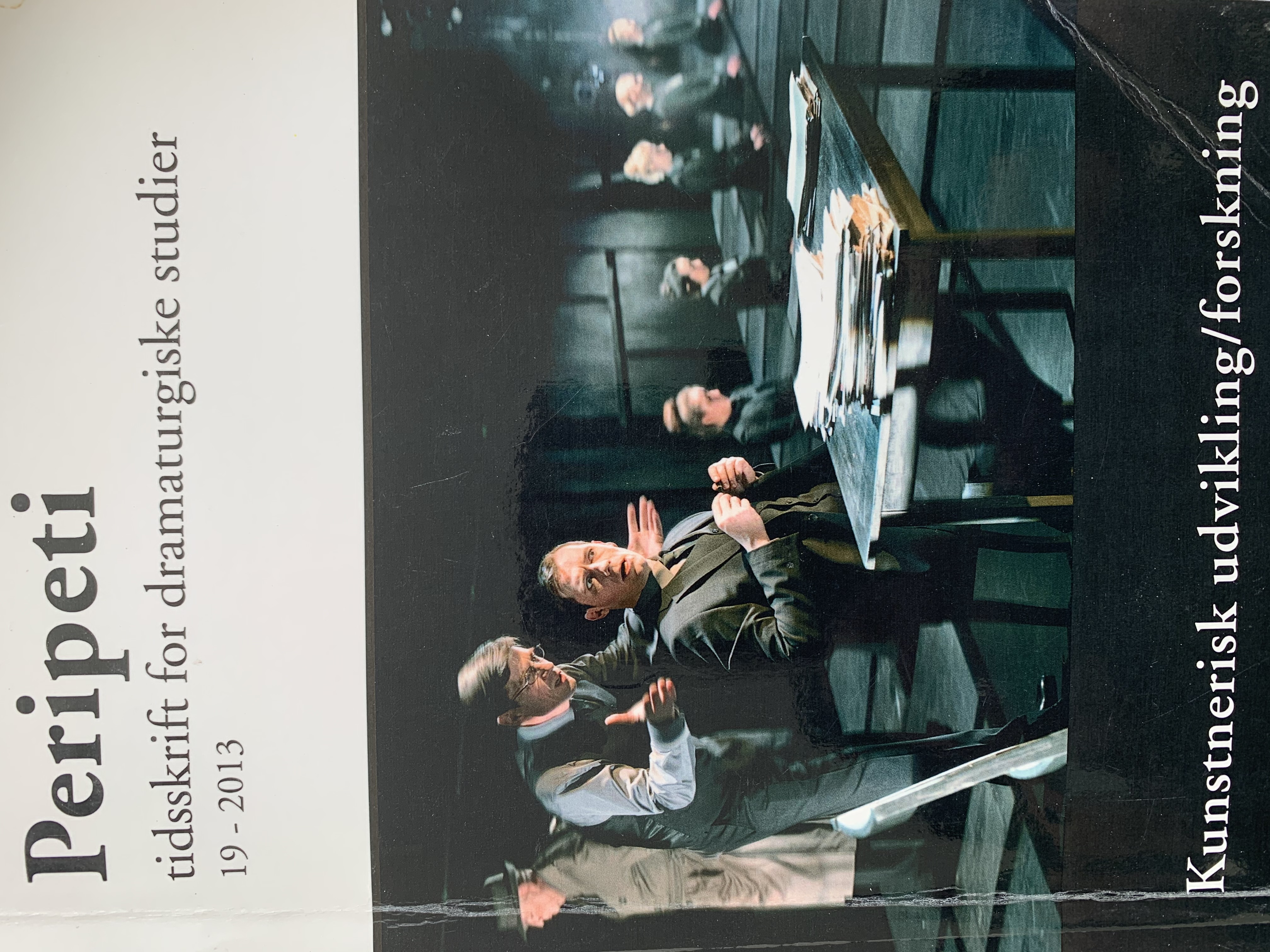What is at stake in ‘the Practice as Research initiative’?
DOI:
https://doi.org/10.7146/peri.v10i19.109034Resumé
This article begins with a brief history of the emergence of Practice as Research (PaR) noting diferent terminology in diferent contexts and marking misapprehensions and misunderstanding arising from a range of standpoints amongst the individuals and institutions involved. It proceeds to lay out adjustments required in making the shift from “practitioner” to “practitioner-researcher” in the context of contemporary HEIs. Sketching some key changes over the past century which have led to a strong advocacy of embodied cognition in recent years, the article sets out a multi-mode approach in an epistemological model for PaR. he model embraces varying modes of knowing: know what; know how; know that. It is the convergence of evidence adduced by diferent modes of research which contributes to the rigour of the overall approach.
Referencer
Barrett, Estelle and Bolt, Barbara (eds), 2010 (2007). Practice as Research: Approaches to Creative Arts Enquiry London & New York: I.B. Tauris.
Butler, Judith, 1993. Bodies hat Matter: On the Discursive Limits of Sex. London & New York: Routledge Classics.
Carter, Paul in Barrett, Estelle & Bolt, Barbara, eds (2010 [2007]) Practice as Research: Approaches to Creative Arts Enquiry London & New York: I.B. Tauris.
Fenemore, Anna (ed), 2012. he Rehearsal: Pigeon heatre’s trilogy of performance works on playing dead. Bristol, UK/Chicago, USA: Intellect.
Gadamer, Hans Georg, 1989 (1960). Truth and Method. Trans, J Weinsheimer and D.G. Marshall. London: Sheed and Ward.
Haseman, Brad, 2010. Rupture and Recognition: Identifying the Performative Research Paradigm. In Barrett, Estelle and Bolt, Barbara (eds) 2010 (2007) Practice as Research: Approaches to Creative Arts Enquiry London & New York: I.B. Tauris.
Haseman, Brad & Jaaniste, Luke, 2008. he arts and Australia’s national innovation system, 1994-2008: Arguments, recommendations, challenges. Occasional paper No. 7. Council for the Humanities, Arts and Social Sciences: Canberra.
Hefce, 2011. REF 2014 Assessment Framework and Guidance on Submissions. Bristol, UK: Hefce
Heidegger, Martin, 1976 (1954). What is Called hinking Trans. J. G. Gray and F.D. Wieck. London: HarperCollins Perennial.
Melrose, Susan, 2006. “he body” in question: expert performance-making in the university and the problem of spectatorship. http://www.eis.mdx.ac.uk/stafpages/satinder/Melroseseminar6April.pdf.
Nelson, Robin (2009) ‘Modes of Practice-As-Research Knowledge and heir Place in the Academy’ in Allegue, L, et al, eds, (2009) Practice as Research in Performances and Screen. Basingstoke. Palgrave Macmillan. 112-130.
Nelson, Robin, 2013. Practice as Research in the arts: principles, protocols, pedagogies, resistances. Basingstoke: Palgrave.
Noë, Alva, 2004. Action in Perception. Cambridge, Mass: he MIT Press.
Polanyi, Michael, 1983. he Tacit Dimension. Gloucester, Mass: Peter Smith.
Popper, Karl, 1963. Conjectures and Refutations. London: Routledge.
Reason, Matthew, 2006. Documentation, Disappearance and the Representation of Live Performance. Basingstoke: Palgrave Macmillan.
Rye, Caroline (2003) Incorporating Practice: A multi-viewpoint approach to performance documentation. In Journal of Media Practice. 3:2.
Ryle, Gilbert (1949). Knowing How and Knowing hat. In Concept of Mind. Harmondsworth: Penguin Books. 26-60.
Till, Nicholas (2013). Feature: Opus versus output. In Times Higher Education. 7 March, 2013: 01. http://www.timeshighereducation.co.uk/story.aspx?storyCode=2002261
Trimingham, M (2002). A Methodology for Practice as Research. In Studies in heatre and Performance. Vol. 22 (1). 54-60. The Quality Assurance Agency for Higher Education, 2011. Doctoral Degree Characteristics www.qaa.ac.uk.
Vygotsky, Lev, 1986 (1934) hought and Language (trans. newly revised and edited by Alex Kozulin). Cambridge Mass: he MIT Press.
Downloads
Publiceret
Citation/Eksport
Nummer
Sektion
Licens
Det følgende vedrører alle Peripeti-udgivelser fra 2024, nr. 39, og senere:
Peripeti er et Diamond Open Access-tidsskrift, der giver direkte open acces til publiceret indhold ud fra princippet om, at det at gøre forskning frit tilgængelig for offentligheden understøtter en større global udveksling af viden.
Forfattere skal ikke betale for indsendelse, redigering eller offentliggørelse af artikler.
Forfattere, der bidrager til Peripeti, bevarer ophavsretten til deres artikler.
Forfattere accepterer at udgive artikler under en Creative Commons CC-BY-NC 4.0-licens. Vilkårene for denne licens tillader brugere frit at kopiere og videredistribuere materialet i ethvert medie eller format og at tilpasse, transformere og bygge videre på materialet, så længe der gives passende kreditering, et link til licensen gives, og eventuelle ændringer angives. Brugere må ikke dele eller tilpasse materialet til kommercielle formål uden samtykke fra licensgiveren. Brugen af licensen må ikke på nogen måde antyde, at licensgiveren støtter tredjeparten eller dennes brug. Licensen kan ikke tilbagekaldes.
Forfattere opfordres til at lægge deres artikler ud på personlige og/eller institutionelle hjemmesider for at sikre endnu større offentlig adgang efter udgivelsen. Forfattere har ret til at arkivere deres artikler i fondes og offentlige institutioners arkiver, men Peripeti anmoder om, at forfattere bruger et direkte link til den publicerede artikel på tidsskriftets hjemmeside, når det er muligt, da Peripeti som en ikke-kommerciel, offentligt finansieret udgiver er afhængig af niveauet af brugeraktivitet på tidsskriftets hjemmeside.
Vedrørende tidligere udgivelser, indtil 2024, herunder nr. 38:
Ophavsretten deles mellem Peripeti og forfatteren/forfatterne. Tidsskriftet er et open access-tidsskrift, der giver direkte adgang til alt indhold baseret på princippet om, at det at gøre forskning frit tilgængelig for offentligheden understøtter en større global udveksling af viden. Brugere kan frit kopiere og dele materiale i ethvert medie eller format, så længe der gives passende kreditering. Enhver anden brug kræver skriftligt samtykke fra indehaverne af ophavsretten.





